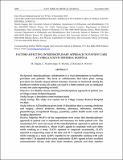Factors Affecting Interdisciplinary Approach to Patient Care at Vihiga County Referral Hospital
Publication Date
2018-11-11Type
Article, Journalviews
downloads
Metadata
Show full item record
Abstract/
Background: Interdisciplinary collaboration is a vital phenomenon to healthcare providers and patients. The level of collaboration that takes place among providers can directly impact patient outcomes. Increase in teamwork among the healthcare workers across all cadres can lead to a better patient care as compared to only one cadre depending on itself. Objective: To identify factors affecting interdisciplinary approach in patient care at Vihiga County Referral Hospital. Study Design: A descriptive cross-sectional study Study Setting: The study was carried out at Vihiga County Referral Hospital (VCRH). Study Subjects: All healthcare givers from 13 disciplines that is, nursing, medicine and surgery, clinical medicine, dentistry, pharmacy, laboratory, nutrition, physiotherapy, occupational therapy, psychiatry, public health social work and imaging department. Results: Majority (96.43%) of the respondents were aware that interdisciplinary approach in patient care is important and necessary for better patient care. The remaining 3.57% were not aware of the interdisciplinary approach in patient care since they do not practice it. About 14.26% agreed to cooperate with each other while working as a team, 21.43% reported to cooperate occasionally, 32.14% reported to cooperating most of the time and 35 % reported cooperating always while working as a team. 42.86% reported to be comfortable working with each other while 7.14 reported to be rarely comfortable. 42.86% agreed to have excellent communication always with their team members, patients and their families while 3.6% reported to rarely have excellent communication with their team members, patients and families. 53.6% reported to negotiate differences of opinions most of the time 46.4% agreed to negotiate differences of opinions among the team members when they arise while 7.14% reported to rarely negotiate differences of opinions. 46.4% reported to encourage each other, patients and their families to use the knowledge and skills that each of them can bring in developing plans of care. Half (50%) of the respondents reported to always encourage and support open communication, including the patients during team meetings while 28.6% reported to occasionally do so. 53.6% of the respondents reported to always understand that they shared knowledge and skills between health professions as 25% reported that most of the time they do so. Conclusion: Majority of the VCRH healthcare givers are aware of the interdisciplinary approach in patient care and its importance. The challenge is how to in-cooperate it into the system. From the study, it was evident that the facility has the potential of achieving IDA in patient care if the barriers are addressed. These can be achieved if all the stake holders are brought on board regardless of the cadre. This will improve the standard of patient care in line with the WHO guidelines.

